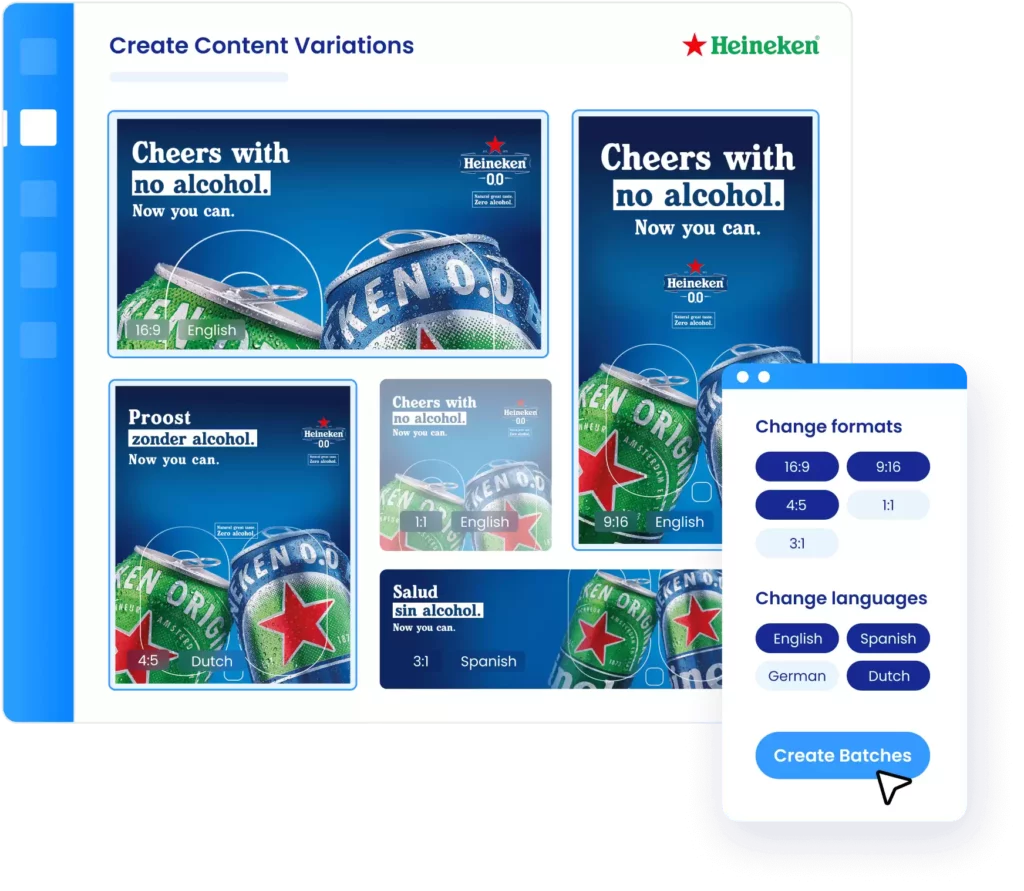Surprisingly, even with limited resources and smaller creative teams, significant improvements to reduce creative turnaround time are possible. This guide aims to give you the strategies you need to tackle this challenge head-on. We’ll begin by exploring the vital role a quick turnaround time plays in today’s online landscape. Then, we’ll delve into three practical steps for achieving improvements, before concluding with insights on the importance of reduced creative turnaround time in the competitive world of marketing.
Why a quick creative turnaround matters
In today’s digital landscape, speed, relevance and hyper-personalisation are the driving forces behind success. To effectively connect with their target audience through videos and banners, marketers must produce content that is not only up to date, but also aligns with current trends and resonates on a personal level with each consumer.
In practice, this translates into the need to create multiple versions of the same ad – a process that demands the kind of time and effort that most organisations simply don’t have. A quicker creative turnaround time helps you tackle this problem, by enabling you to:
Meet tight deadlines
A quick turnaround time allows marketers to produce a greater volume of creative content within a shorter time frame. This agility ensures that marketers have a wealth of content readily available for various events, guaranteeing that they can consistently meet deadlines and remain responsive to ever-evolving trends and consumer expectations.
Seize trends & adapt to changing market dynamics
The ability to harness emerging trends is a game-changer in marketing. A swift turnaround time means marketers can adapt their content at pace to ride the wave of trends. With this agility, they’re able to seize opportunities as they arise, ensuring that their campaigns remain fresh, relevant and aligned with the changing tastes and preferences of their target audience.
Test & iterate fast
A ‘one-size-fits-all’ approach rarely delivers the best results. Instead, marketers must tailor their campaigns to different segments and pinpoint what works best – a time-consuming process. However, a quick creative turnaround time enables marketers to rapidly deploy and assess these variations. They can gather insights, make data-driven adjustments and optimise their campaigns on the go.

Stay ahead of the competition through speed
In a highly competitive environment like the marketing sector, a fast turnaround time becomes a strategic imperative, allowing marketers to promptly implement fresh ideas and respond to market changes. This agility gives them a competitive edge, with the ability to adapt to shifts in consumer preferences and outpace rivals by consistently delivering content that captivates and converts.
Enhance customer engagement with personalised content
Customer engagement is the lifeblood of successful marketing. It’s the measure of how effectively a brand connects with its audience, and it often hinges on delivering timely and relevant content. By responding to customer needs and preferences at pace, marketers can nurture stronger connections, boost loyalty and ensure that their brand remains at the forefront of the customer’s mind.
As we can see, a quick creative turnaround time unlocks numerous advantages for brands. In the next section, we’ll explain the tangible ways you can go about achieving it.
How to improve your creative turnaround time
Reducing creative turnaround time can be accomplished by following three simple steps: Collect data and insights, identify bottlenecks and automate where possible.
1. Measure and analyse turnaround times
Improvement begins with understanding. Initiate the process by gathering qualitative insights through interviews with team members in both the marketing and creative departments. Engage in conversations to get the valuable feedback you need: how can we optimise your work efficiency?
Moreover, it’s key to initiate quantitative data collection. Begin by measuring the current duration required for crafting a single advertisement, as well as producing multiple versions. Conduct precise timing for each task, encompassing the entire journey from ideation to creation, and establish key performance benchmarks.
This qualitative and quantitative data will give you a comprehensive perspective on your creative turnaround times, providing a foundation for informed enhancements, while enabling you to identify your most important bottlenecks.
2. Identify bottlenecks
Which brings us to this. With data and interview insights at hand, you can now pinpoint the major bottlenecks within your organisation. Some of the most common obstacles hindering swift content creation include:
- Inefficient use of resources
- Excessive manual work
- Lack of communication between marketing & creative departments
- No workflows in place
- No feedback loops implemented (or too many!)
3. Automate creative production processes
Whether your bottleneck is down to project management, communication, or lengthy manual tasks, the key to overcoming it often lies in the adoption of appropriate tools, and of automation.

Conclusion
A swift creative turnaround time is often the backbone of any success in the fast-paced, competitive arena of digital marketing. Meeting tight deadlines, capitalising on trends, iterating rapidly, outperforming competitors and enhancing customer engagement are all vital aspects of modern marketing.
This guide has highlighted the significance of a quick creative turnaround time and provided a road map for its achievement. By collecting data, identifying bottlenecks and embracing automation, organisations can empower both their marketing and creative teams to flourish.
In an era when time is of the essence, a reduced creative turnaround time isn’t just a goal; it’s a strategic imperative to stay ahead in the competitive world of marketing.
Want to read more about how Creative Automation can help you?
Then have a look at how Heineken reduced their overall production costs by 40% with the help of Storyteq’s Creative Automation. Read their story here!





